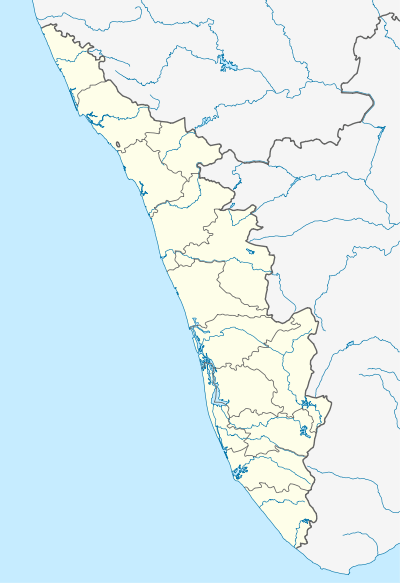Kunhimangalam
| Kunhimangalam | |
|---|---|
| village | |
.jpg) Kunhimangalam Junction | |
 Kunhimangalam Location in Kerala, India  Kunhimangalam Kunhimangalam (India) | |
| Coordinates: 12°3′10″N 75°14′20″E / 12.05278°N 75.23889°ECoordinates: 12°3′10″N 75°14′20″E / 12.05278°N 75.23889°E | |
| Country |
|
| State | Kerala |
| District | Kannur |
| Population (2001) | |
| • Total | 18,014 |
| Languages | |
| • Official | Malayalam, English |
| Time zone | UTC+5:30 (IST) |
| ISO 3166 code | IN-KL |
Kunhimangalam is a village situated in the northern coastal part of Kannur District in Kerala state on the outskirt of Payyanur. The population in 2011 was around 19,000 including Christians, Hindu and Muslim residents. The village lies in an agricultural region.
History
The local myth of the origin of Kunhimangalam is that a Namboodiri family known as "Kunhaangalam Taravadu" were the village leaders. They ruled the village in an acceptable manner but over the time the family line ended, there was only a mother and son left. One day, the mother and son went to the Kaveri river to pray for their deceased relatives. On their way back to the village, they saw from the Gadikuzhi hills some soldiers of the ruler of Chirakkal town taking Kunhimangalam. The mother and son ended their life in fire. The mother emerged as the Goddess "Veeracha mundi"[1] and the son as the God "Veeran". The local people built a temple, the "Kunhimangalam Molom" at the site of the "tharavad" (ancestral home).
An early ruler in the area of Kunhimangalam was Ezhimannan of Ezhimala. In Sangam literature, the area was called "Ezhil Malai" meaning "high hillock". Other terms have included "Elimala", "Mooshika Sailam", "Sapta Sailam", "Mount Eli" and "Mount the Eli".
From the 6th century CE to the 11th century CE, Kunhimangalam lay in the lands of the Mushika Kingdom. The Ezhimala hills were known for their rare medicinal herbs that had with mythological significance. Carved stone pillars, prehistoric stone forms, burial chambers, caves and granite platforms are visible at the foot of the hills. Sailors came to Ezhimala for the beach and views from the hills. A lighthouse was built at nearby Mount Dili.
The western approach to Kunhimangalam is called "Changoorichal" after a Chinese ship, the Changu which visited the area in the 12th century CE. The 13th century CE merchant traveller, Marco Polo (1254 - 1324) recorded the place name "Ezhimala".
In 1962, the village of Kunhimangalam was granted its own panchayat (local council). The council met in a rented building in Theru. The first council chairman was U. Kunhiraman who held office for twenty-four years. administered the panchayat under his commanding guidance for more than 24 years. A recent council chairman is M. Kunhiraman.
Location
Kunhimangalam is located in the northern part of Kerala state on the south-eastern outskirts of Payyanur. The village lies on the south shore of the Perumba River. The village lies on National Highway 66 The village's railway station is the Ezhimala station. The nearest cities to Kunhimangalam are payyannur (8 km) Mangalore (114 km) and Kannur (31 km).[2]
Demographics
In 2011, the population of Kunhimangalam was 18,965. 10,527 were female. 10.37 percent of the population were children under six years.[3]
Religion

.jpg)
Kunhimangalam is home to Hindus, Muslims and Christians. There are two main churches in the village, at Kovvappuram and the Capuchin Church at Edat. The main mosque is the Jamayeth Mosque. The main Hindu temple is the Muchilottu Bhagavathi. There are also temples such as Sree Muthappan, the deity of the common man, sree thrippanikkara shiva kshethra and the Aneekkara Poomala Bhagavathi Temple.
Economy
The village is the centre of a fertile agricultural region. There are paddy fields, coconut trees, cashew nut trees and areca nuts plants. Other sources of employment are Beedi-cigar works, weaving, earthen ware pottery (at Koyappara). Clothes are made at Saliya theru (weavers' market), and bronze vessels such as lamps and sculptures at Moosarikkovval.[4] Fish are caught in the Pullankode river. Kunhimangalam was once self sufficient but now relies on foreign currency from exports to the Gulf Countries.
Education

Kunhimangalam has seen changes in education related to the Indian nationalist movement and the Indian agricultural movement. In 2011, at the Indian census, the rate of literacy in the village was 94.39 percent. The rate in women was 92.09 percent.[3]
The schools in the village include:
- Government Lower Primary School. The first school in Kunhimangalam. Its first headmaster was P. M. Ramunni.
- Edanad West Lower Primary School. The first headmaster was a Mr Raghavan.
- Edanad Upper Primary School. The founder and first headmaster was V. V. Chindankutty Nayanar.
- Gopal Upper Primary School (1914). The founder and the first headmaster was C. V. Gopalan Nambiar.
- Kendriya Vidyalaya.
See also
- Payyannur
- Valiyaparamba Backwaters 15 km from Payyanur
- Peringome 20 km from Payyanur
- Ezhimala 12 km from Payyanur Town
- Kavvayi Island 3 km from Payyanur
- Ramanthali 7 km from Payyanur
- Karivellur 10 km from Payyanur
- Trikarpur 6 km from Payyanur
References
- ↑ Kumar S. The Gods, Demons and People of Kunhimangalam Leadstart Publishing 2015. ISBN 9352013808, 9789352013807 Accessed 25 June 2017.
- ↑ "Mangalore to Malliyottu Palottu Kavu, Kunhimangalam". India Rail Info. Retrieved 8 October 2017.
- 1 2 Kunhimangalam Census 2011. Accessed 25 June 2017
- ↑ Logan W. Malabar Manual Asian Educational Services, 1887. ISBN 8120604466, 9788120604469 Accessed 25 June 2017.
| Wikimedia Commons has media related to Payyanur. |